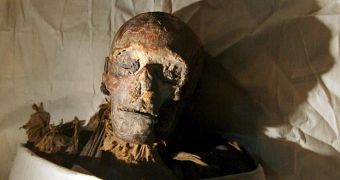Last week, perhaps the most significant finding from the ancient Egypt was announced, ever since the discovery of the tomb of Tutankhamun by the English archaeologist Howard Carter in 1922.
In 1903, Carter had come across two sarcophagi in a tomb marked as KV60 in the Theban necropolis, the Valley of the Kings in Luxor. One apparently harbored the mummy of Hatshepsut's wet nurse Sitre-In and the identity of the other mummy remained unknown. When in 1920 he found the tomb of Queen Hatshepsut, the two sarcophagi were empty.
CT scans have connected distinct physical traits of one mummy to that of her ancestors. The box containing the tooth had Hatshesupt's name written on it and the box scanning revealed that the tooth matched within a fraction of a millimeter the space of the missing molar in the mouth of the mummy. DNA comparisons with a female royal relative who died long before support the finding.
The importance of the discovery is that this is the first clearly royal mummy since Tutankhamun was found. Perhaps the most fascinating woman of the ancient Egypt was not Cleopatra (which was not even Egyptian, but Greek), but the female Pharaoh Hatshepsut, who ruled in the 15th century B.C.
The mummy's analysis shows Hatshepsut was a 50-year-old fat lady; apparently she enjoyed eating well and abundantly and she could have had diabetes, like many obese women today.
Stylists seem to have missed this period of Egypt: like a real living dead, Hatshepsut was balding in front but let the hair on the back of her head to grow in long locks. She also sported black and red nail polish, typical for ancient Egypt, but from horror movies in our days. (Cleopatra was also an ugly duck).
Hatshepsut, the daughter of Pharaoh Tuthmosis I - who ruled from 1504-1484 BC - was perhaps the most powerful female monarch of the ancient world.
She married one of her half brothers, Thutmose II and helped him rule Egypt as his "Great Royal Wife."
When her husband died, Hatshepsut was named regent for his son, Tuthmosis III, whose mother was Thutmose's concubine, but quickly grabbed the throne for herself. She proclaimed herself as pharaoh, wearing royal headdress and a false beard.
She ruled for 22 years, more than any female ruler before or after her and left behind many buildings and sculptures, including her tomb, Djeser-Djeseru, an architectural wonder.
Her successor, Thutmosis III tried to erase any trace of her by chiseling her name, symboling off everything and destroying her monuments and tomb. He moved her to the obscure tomb and left her there to dry up with just the mummified nurse for company; that is why researchers thought for a long time that her mummy was lost.

 14 DAY TRIAL //
14 DAY TRIAL //